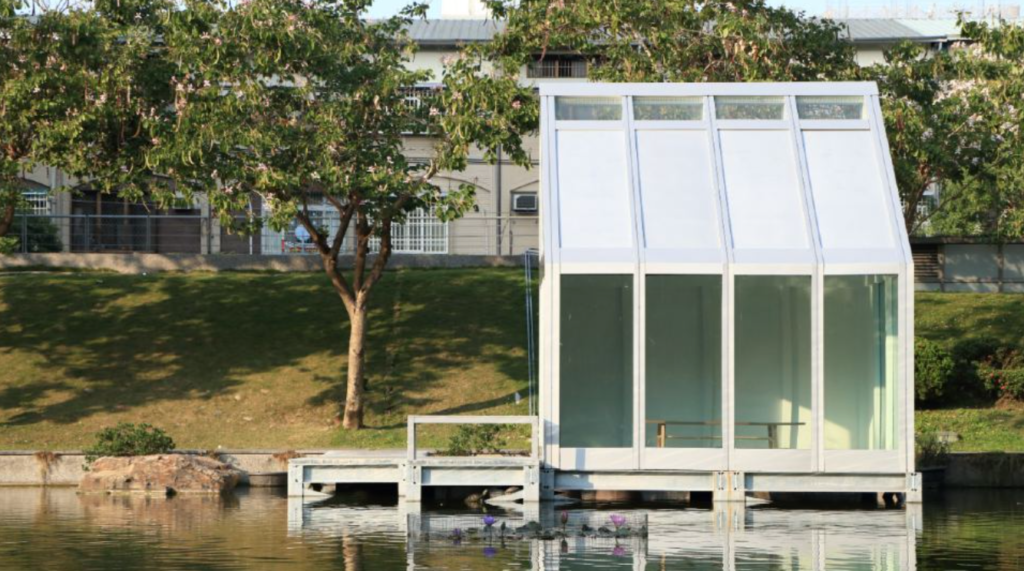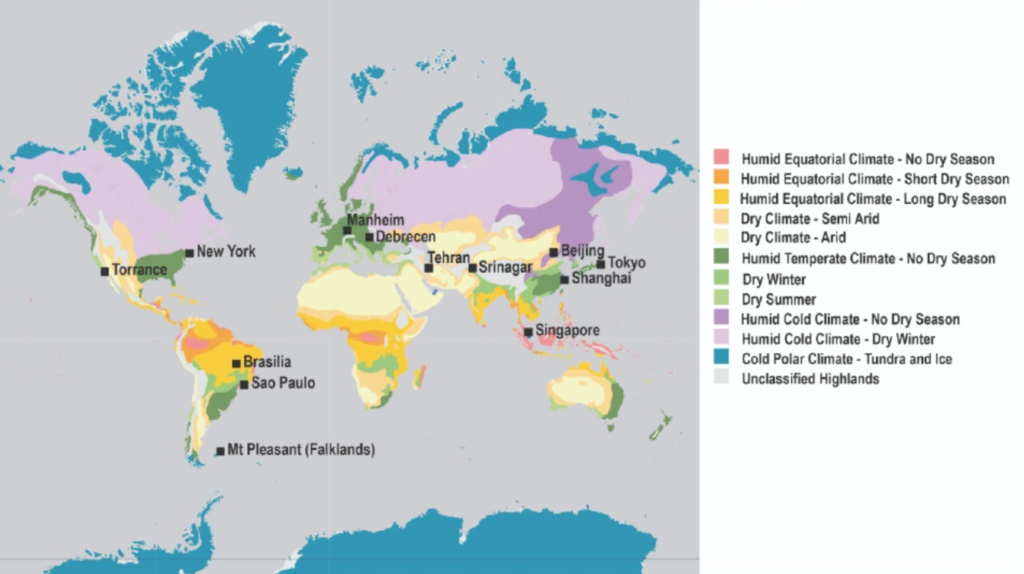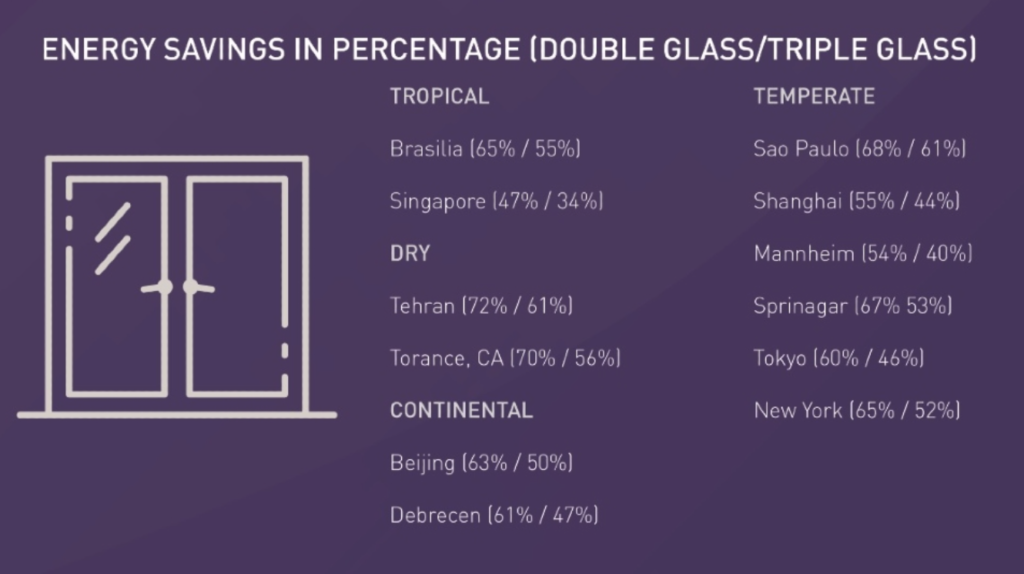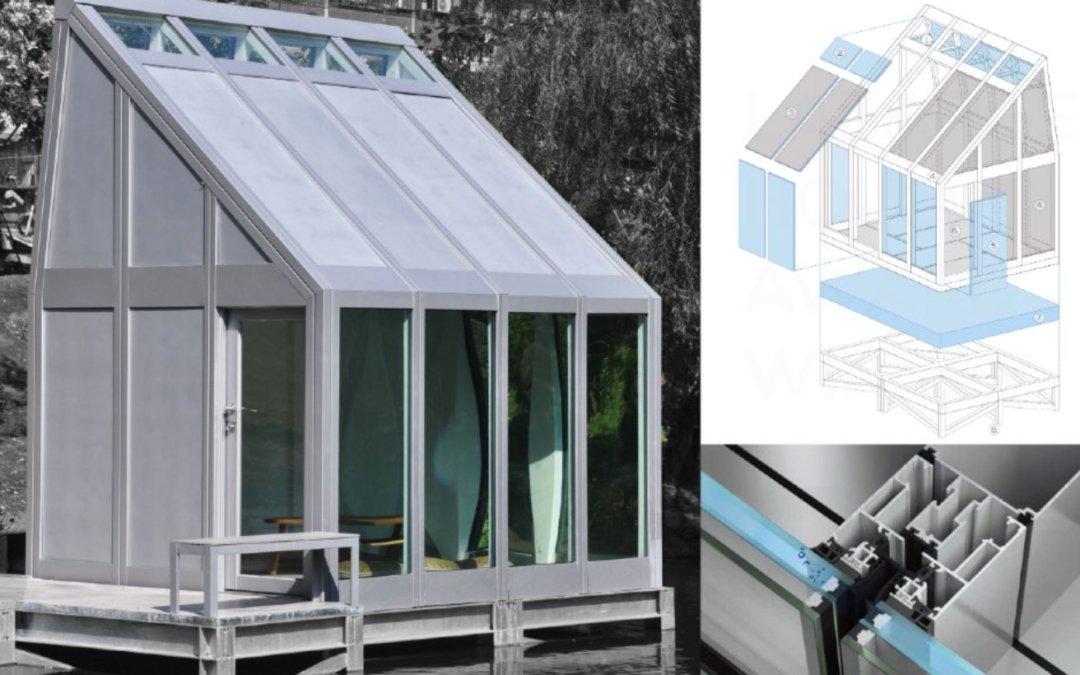Article and Images Source: Loughborough University
Article Link: https://www.lboro.ac.uk/media-centre/press-releases/2020/july/water-filled-glass-research-paper/
- Loughborough University’s Dr Matyas Gutai is the creator of ‘water-filled glass’(WFG) and two novel ‘water houses’
- The WFG system he has developed uses water to heat and cool structures in a bid to reduce energy use and carbon emissions
- His latest study reveals that WFG systems can save energy in all inhabited climates
- Simulations show it can save up to 72% more energy than buildings fitted with traditional heating systems and double glass
- And up to 61% more energy than buildings fitted with traditional heating systems and triple glass
- The next step for Dr Gutai is to develop the technology into a marketable product
Most everyone knows that heating and cooling buildings is not only expensive but a massive issue due to the resulting carbon emissions.
According to the UK Green Building Council, the built environment contributes around 40% of the UK’s total carbon footprint – with heating alone contributing to 10% of the total.
To tackle our carbon issue, Dr Matyas Gutai says we need to turn our attention to improving windows.
Though the area they occupy may be small on a building, their insulation capacity is much worse than a normal wall surface and small changes can lead to up to 25% energy savings for the whole building.
The School of Architecture, Building and Civil Engineering academic says he has found a material that can save more energy than current technologies on the market – including double and triple glazing: Water.
Dr Gutai has been researching the concept for over a decade and his latest study, published in Elsevier’s Energy and Buildings Journal in collaboration with Dr Abolfazl Kheybari, of the University of Kaiserslautern, demonstrates how ‘water-filled glass’ (WFG) can revolutionize building design and performance when used as part of a wider heating system.
The research reveals that WFG systems perform well in any inhabited climate – keeping buildings in hot climates cool, and buildings in cool settings warm – without requiring an additional energy supply, highlighting the technology’s potential to make a real splash when it comes to reducing carbon emissions.
What is water-filled glass?
WFG involves a sheet of water being trapped between a panel of glass, and the water is practically invisible.
Dr Gutai developed the concept while studying for a PhD at the University of Tokyo after being inspired by Japanese outdoor baths – known as ‘rotenburo’ – which are used also during the winter as the water’s thermal properties keep us warm.

Dr Gutai developed the idea into a working design and then created two prototype buildings in different climates – Hungary and Taiwan – that use WFG as part of a larger mechanical system.
The WFG system involves connecting the water-filled window panels to a storage tank using pipes hidden in the walls, so fluid can circulate between the two.
This system allows the ‘Water Houses’ to cool and reheat themselves, without needing an additional energy supply for most of the year.
When it is warm, the buildings stay cool as the water absorbs external and internal heat; this warm water is then circulated to the storage tank– which can either be in the foundations or placed somewhere in the building.
The heat is stored in the tank and, if the temperature drops, it can be brought back to the walls to reheat the building using a monitoring system similar to central heating. Alternatively, the stored heat can be used for hot water supply.

The reason why this process saves energy is because water absorption and pumping take much less energy than HVAC systems (heating, ventilation, and air conditioning).
The technology also has other benefits, including acoustics, less need of ‘shading’ (methods used to avoid overheating and the greenhouse effect), and there is no need to colour the glass to improve energy efficiency, so it has aesthetic benefits too.
Dr Gutai has developed a more sophisticated version of the system by adding a heat pump, which can heat and cool the water depending on the season – and this is the system he examines in the latest research paper.
Loughborough research and key findings
Dr Gutai joined Loughborough University in 2017 and has used data gathered on the two Water Houses to develop a simulation system that can evaluate the energy performance of such structures.
His latest paper uses simulations to compare the performance of the WFG system (with heat pump) against a typical building heating system (i.e. windows paired with gas heating and air conditioning).
For the study, Dr Gutai focused on the annual energy consumption for a typical office space (17.5m2) with one glazed façade of equilateral orientation (south in the northern hemisphere).
He used the simulation to explore how this office with a WFG system would fair in 13 cities from all major climate regions – tropical, dry, temperate, continental and polar.

For the traditional systems, Dr Gutai looked at the performance of double glass window with low-e (a type of radiation coating), and triple glass – which are filled with gas, specifically argon gas, as opposed to a liquid.
The main findings of the study are:
- The WFG system is able to use the absorption of the water effectively to improve the energy performance of glass
- The water layer lowers the load for heating and cooling effectively, minimizing daily and seasonal peaks
- The WFG system saves energy in all major inhabited regions (every climate region except polar) with savings of:
- 47%-72% compared to double glass (with low-E) and
- 34%-61% compared to triple glass

The simulations also highlighted that current glass technologies could lead to bigger energy savings if more focus was put on improving solar absorption as opposed to insulation.
Of the research’s importance, Dr Gutai said: “Glass is currently a liability in buildings as it compromises energy consumption, thermal comfort, acoustics and other aspects.
“WFG changes this paradigm and turns glass into an opportunity for sustainable construction.
“It shows us that thinking holistically about buildings and building components leads to a more efficient and sustainable built environment.
“In case of a window for example, if we see it as an isolated system, solar overheating is a challenge that needs to be remedied with cooling.
“If we approach this holistically, the heat surplus is an opportunity because the same heat is missing from somewhere else (i.e. colder part of the building or hot water supply).”
Dr Gutai is now looking to develop this technology into a product and is working with colleagues in academia and enterprise to achieve this goal.
He is also to build on the research by comparing WFG with dynamic glazing, evaluating life-cycle impact and simulating thermal comfort.
Dr Gutai’s latest study, titled ‘Energy consumption of water-filled glass (WFG) hybrid building envelope’, can be found in its entirety here.

